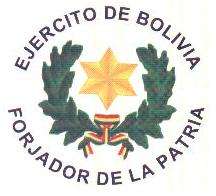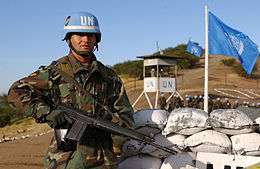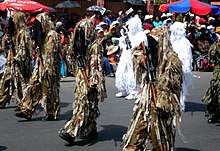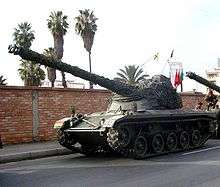Bolivian Army
| Bolivian Army Ejército de Bolivia | |
|---|---|
 The Bolivian Army's seal | |
| Active | 1810 |
| Country |
|
| Allegiance |
|
| Branch | Army |
| Motto(s) | "Army of Bolivia, Forger of the country." |
| March | Bolivian Army Song |
| Anniversaries | 6 August (Independence Day) |
| Commanders | |
| Commander-in-Chief | President Evo Morales |
| Ceremonial chief | General Marcelo Antezana |
The Bolivian Army or Ejército Boliviano is the land forces component of the Armed Forces of Bolivia. On average, the army consists of 31,500 men.
.svg.png)

Organization
Combat units directly under the Army general command
- 1st Infantry Regiment Colorados (Presidential Guard), contains two 2 battalions: BI-201 and BI-202
- BATCOM-251,
- Gen. maintenance cen. no. 1
- Transport batt. no. 1.
- 1st National parks Security Regiment
Special forces command
The Special Forces command controls the following units:
- 12th Ranger Regt. "MANCHEGO", Montero
- 16th Infantry Regt. JORDAN, Riberalta (Special Forces)
- 18th Parachute Infantry Regiment VICTORIA "Army Special Troops Training Center", Cochabamba
- 24th Ranger Regiment (Mountain) MÉNDEZ ARCOS, Challapata
Army aviation command
Army aviation company 291 (La Paz), army aviation company 292 (Santa Cruz)
- 291st Cavalry Group (La Paz)
Regional
The Bolivian Army has six military regions (regiones militares—RMs) covering the various Departments of Bolivia:
- RM 1, La Paz, most of La Paz Department: 1st Army Division, 297th MPB C.L.Saavedra (Military Police battalion), 296th En Btn CNL R.C.Zabalegui(ecological batt.), BE-297 (ecolog. batt.), BATLOG-1 (Logistics btn.), army aviation company 291 C.L.Cordoba, Mili. hospital no. 1, Military Police School, Army Equestrian Center, Military College of Bolivia "COL Gustavo Villaroel Lopez", Army School of Intelligence, Army Engineers School MCAL Antonio Jose de Sucre, Army Signals and Communications School, Army Armor School, Army 1st Engineering Regiment CPN Felipe Ochoa "Army Engineering and Maintenance Center", Bolivian Army Military School of Music "LTCOL Antonio Patino"
- RM 2, Potosí, covering the departments of Oruro and Potosí: 2nd and 10th ADs, 24th RR M.Arcos (ranger regt.), ADA-202 (a.a. group), Army Mountain School
- RM 3, Tarija, consisting of Tarija Department and eastern Chuquisaca and southern Santa Cruz:3rd and 4th AD
- RM 4, Sucre, covering the departments of Cochabamba and northern Chuquisaca: 7th Army Division, 272th MP Btn., BATLOG-2 (long.Batt), mili.hospital no2, Army Arsensals Cochabamba, Army Command and Staff College MSHL Antonio de Santa Cruz, Army NCO School "SGT M. Paredez", Army Artillery School, 18th PIR "Victoria" (Army Special Troops Training Center), Army NCOs and Warrant Officers Advance Studies Institute, Army Arms Applications School, 1LT Edmundo Andrade Military High School
- RM 5, Cobija, encompassing the Pando Department and parts of La Paz and Beni departments: 6th AD, 16th IR Jordan (special forces), Army Jungle Operations School
- RM 6, Santa Cruz, covering most of Santa Cruz Department: 5th and 8th ADs, BMP-273 R.Amezaga (Military Police), BE-298 (ecological batt.), 12th RR Manchego (ranger), BATLOG-3 (logist. batt.), 292 army aviation company, Bolivian Condores school (special forces), 6th IR
Army Divisions
The army is organized into ten territorial divisions, titled Army Divisions (AD), plus a mechanized division, each of which, with the exception of Viacha, occupy a region generally corresponding to the administrative departments, with some overlapping. These and their respective divisional headquarters and constituent units are:
- 1st Mechanized Division, Viacha (La Paz Department): 1st Field Artillery Regiment "Camacho", 6th Air Defense Artillery Regiment, 23th IR (Mechanized Infantry Training), 4th IR Tarapaca (Mech.) 5th ACR, 2nd ACR (Training), 1st Armor Regiment
- 1st AD, Viacha (La Paz Department): 8th IR Ayacucho, RI 30 Murillo (mountain), RA 2 Bolivar, Bat.Ing. 2 G.F.Roman.
- 2nd AD, Oruro: 21st IR Illimani (Mountain), RI 22 Mejillones, 25th RI (Mountain) Tocopilla, RC 8 Braun, 1st Artillery Regt. Camacho, Bat.Ing. 7 Sajama.
- 3rd AD, Villamontes (Tarija Department): 5th IR Campero, RI 20 Padilla, RC 3 Aroma, RA 3 Pisagua, Bat.Ing. 1 Chorolque.
- 4th AD, Camiri (Santa Cruz Department):, 6th Infantry Regiment Campos, RI 11 Boqueron, 1st Cavalry Regt. "E. Avaroa", RA 4 Bullian
- 5th AD, Roboré (Santa Cruz Department): RI 13 Montes, RI 14 Florida, RI 15 Junin, RC 6 Castrillo, RA 5 Vergara
- 6th AD, Trinidad: RI 17 Indepedencia, RI 29 Echevarria, RI 31 Rios, RI 32 Murguia, 2nd Cavalry Regt. Ballivan, 8th AR Mendez(reserve), Bat.Ing. 6 Riosinho.
- 7th Army Division, Cochabamba (the largest):, 2nd Infantry Regiment "Marshal Antonio Jose de Sucre", 18th Parachute Infantry Regiment "Victoria" (Army Special Troops Training Center), RI 26 R.Barrientos (mech.) 29th PIR "CPT V.Ustariz" (airborne), RA 7 Tumusia, Bat.Ing.5 T.N.Ovando
- 8th AD, Santa Cruz: RI 7 Marzana, RI 10 Warnes (mech.), RC 10 G.M.J.M. Mercado, RA 9 Mitre (reserve), Bat.Ing. 3 Pando.
- 9th AD (Reserve), Rurrenabaque: the Division has been reduced to reserve status and its component units have been divided up between DE-1 and DE-6
- 10th AD, Tupiz: 3rd IR "Juan Jose Perez", RI 4 Loa, RI 27 Antofagasta, 7th ACR Chichas (Armored Cavalry), RA 12 Ayohuma (reserve)
Regimental abbreviations
RI/IR/PIR: infantry regiment
RC/ACR: cavalry regiment
RA: artillery regiment
Bat.Ing.: Engineer battalion
The ten divisions control the following units:

- eight cavalry regiments, included two mechanized regiments
- twenty-three infantry regiments included two airborne and two mountain
- one recce. mechanized regiments and one armored regiment
- two ranger regiments and one special forces regiment
- six artillery regiments and plus three in reserve
- one artillery and anti-air group
- one artillery and anti-air Regiment
- three military police battalions
- three ecological battalions
- two army aviation companies
- six engineer battalions
- Plus logistical and instructional support commands
- Presidential Guard (Bolivian Colorados Regiment) infantry regiment under direct control of the army headquarters in La Paz's Miraflores district
The Army maintains a small fleet of utility aircraft, primarily to support headquarters.
Equipment



| Bolivian army equipment[1] | |
| Tanks | 54 SK-105 Kürassier+ 2 4K4FA-SB20 Greif-Recov+ 2~4 M578 Cherry Picker-Reco. |
| Reconnaissance vehicles | 24 EE-9 Cascavel,
50 HMMWV |
| Armoured Personnel Carriers | 50 M113 armored personnel carriers with local upgrades,
24 EE-11 Urutu APC, 15 Cadillac Gage Commando V-150, 24 MOWAG Roland (locally upgraded; used by the military police) |
| Artillery | 18 Type 54 122mm howitzers,
20 10.5 cm leFH 18 105mm howitzers. 6 M101 105mm howitzers, 6 Bofors L/40 M1935 75mm howitzers . Mortars: M120 120mm, M30 107mm mortars, 250 M29 81mm mortars, FM 81mm, W87 81mm, M-60 60mm, Type 63-1 60mm, M224 60mm mortars Anti-Air: 16 2x37mm Type 65, 80 2x20mm Oerlikon K20, 50 HN-5 MANPAD Surface-to-air missile Anti-Tank: 2,000 66mm M72A3 LAW, 90mm M-20 Super-Bazooka, 40 HJ-8B Red Arrow ATGM |
| Transport | Transport vehicles: DongFeng EQ 2081/2100, FEW C A4140K2E4R7A, Stayer 1491, 16 Ford F-750, ZIL-131, Unimog 416 Dodge M-37 2½ ton trucks, Engesa EE-15 trucks, 597 Engesa EE-25 trucks, FIAT IVECO 619 5 ton trucks
Tactical transport vehicles: 30 M988 HMMWV, 40 Koyak (local production) Utility transport vehicles: M151, CJ-5, CJ-7, Jeep Wrangler, BJ 2020VJ, horses (still used by the Bolivian cavalry units) [1] |
| Small Arms | Handguns: Browning Hi Power, Glock 17, Beretta 92F, S&M mod.10 all 9mm, M1911A1 (.45ACP)
Sub-Machine Guns: FMK-3, UZI, MAT 49 Assault Rifles: 5,56mm; Galil AR, M-16A1, Steyr AUG A1, SA-80. 7,62mm; FN FAL, SIG 542, SIG 510-4, Type 56-2 (AK-47), Sniper Rifles: Dragunov SVD, Mauser mod . 86SR, Steyr SSG 69P1 Anti-materiel Rifles: Steyr HS .50 Machine Guns: M60, FN MAG 60-20, SIG MG 710-3, Type 56 LMG Grenade Launchers: Type 87 35mm, MM-1, M79, M203 Shotguns: Remington 870 and Remington 11-87 . |
| Aircraft | Type | Versions | In service[2] | Notes |
|---|---|---|---|---|
| Beechcraft King Air | Staff transport | Model 90 Model 200 |
1 1 |
|
| Cessna 206 Stationair | Utility | 4 | ||
| Cessna 421 Golden Eagle | Staff transport | Cessna 421B | 1 | |
| CASA C-212 Aviocar | transport | 1 | Center of instruction of special troops |
Uniforms
Army officers, NCOs, and enlisted personnel generally wear gray service uniforms. For tropical areas they wear gray-green service uniforms. Army fatigue uniforms are olive green, and combat uniforms consist of US woodland pattern camouflage and Desert pattern camouflage. The standard headgear for enlisted personnel is the beret bearing the national colors red, yellow and green. Armored troops are distinguished by black berets, and paratroops also by black berets. Special forces wear distinctive camouflage uniforms with green berets.
References
- 1 2 "Archived copy". Archived from the original on 2009-02-09. Retrieved 2009-08-28.
- ↑ "World Military Aircraft Inventory", Aerospace Source Book 2007, Aviation Week & Space Technology, January 15, 2007.